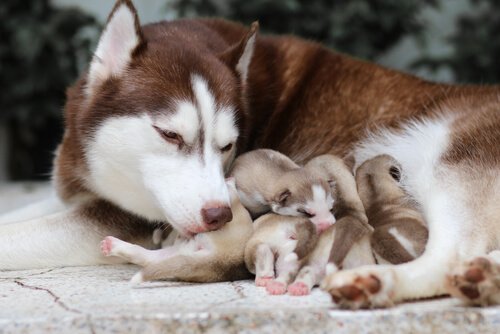How to Help a Dog Give Birth

Witnessing the miracle of life is beautiful regardless of whether it’s a person or an animal. It is even more enjoyable when you already have an emotional bond with the new mother. Therefore, seeing your dog give birth is one of the most beautiful things you could see.
Here are some tips for you to help your dog during labor and enjoy this moment together.
How to know if a dog is about to give birth
Female dogs act very differently than people during labor, so don’t expect any loud noises to warn you about the puppies being on their way.
We understand if you have questions about when your dog will be giving birth. So, here are some signs indicating when the birth is about to happen:

- Digging. Although not all dogs act the same way, this behavior is practically universal. Digging a den gives them a warm, cozy place to keep their puppies from escaping.
- Milk starts leaking out of the teats. It is very common for milk to start leaking just before giving birth.
- Loss of appetite. Just before birth, constant movement from the puppies inside the womb causes nausea. This causes your dog to lose her appetite.
- Vomiting. This also can be caused from the puppies moving inside the womb. There’s nothing to worry about. Just let her rest and pet her so she doesn’t feel lonely.
- She will be relaxed. When your dog is about to give birth, she may lie down, keep quiet and pant a little bit. At this stage it is very important to have water nearby in order to keep her hydrated.
How can you help your dog give birth?
It’s time to attend to your dog once you notice signs of labor. How can you do this?
- Prepare a quiet place for her. Prepare a cozy place where other pets can’t get in a few weeks before labor. Show her the place and take her there once noticing any of the aforementioned signs.
- Do not interfere with the labor unless necessary. The mother will give birth to the puppies. You do not have to worry if they come out head or tail-first; both positions are normal. The mother will clean the placenta and chew off the umbilical cord.
When is your help necessary?

- If for whatever reason, the mother is unable to break off the placenta, you must do it for her. Break it off gently and place the puppy next to the mother.
- Another time you can help the mother is when she starts cleaning her puppies by licking off the amniotic fluid. If there are too many puppies, you can help by gently cleaning them with a soft damp cloth.
- Pups are born around every 30 minutes. Be sure to call the vet if you notice that none are coming out after that time. Likewise, you will need to have a veterinarian present if your dog continues having contractions after pushing out all the puppies.
- Watch the puppies. It is common for a puppy to die within a few minutes or hours after birth. The mother cannot do much to help, but you can. If you notice one of the babies is not breathing, clean his mouth and gently rub his body to see if you can revive him. If you are unable, remove him from the litter so the mother does not eat him and the other puppies don’t get close and smell him.
When it’s all done, watch over the mother to prevent her from rejecting one of the pups and to assure that she feeds them all. Keep feeding the new mother nutritious food so she stays strong and takes care of her puppies.
All cited sources were thoroughly reviewed by our team to ensure their quality, reliability, currency, and validity. The bibliography of this article was considered reliable and of academic or scientific accuracy.
- Sánchez Riquelme, A., & Arias Ruiz, F. (2017). Biología gestacional y predicción del parto en la perra. Revista de Investigaciones Veterinarias del Perú, 28(4), 771-783.
- de Tejerina, J. C. D. F., Vega, F. J. P., & Llamazares, B. C. (1994). Parto y distocias en la perra y en la gata. Clínica veterinaria de pequeños animales: revista oficial de AVEPA, Asociación Veterinaria Española de Especialistas en Pequeños Animales, 14(4), 223-241.
- Martí, S. (2006). El parto de la perra. COVELMA Pequeños Animales, 34-38.
This text is provided for informational purposes only and does not replace consultation with a professional. If in doubt, consult your specialist.